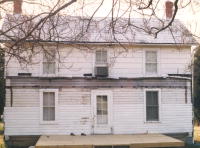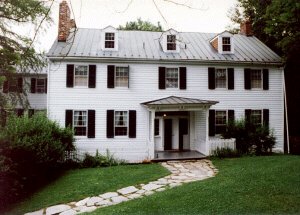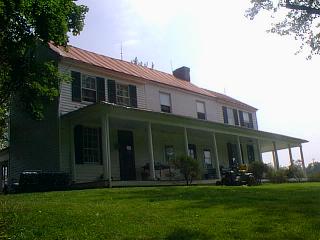| � Home |
| � In The Civil War |
| � Future of the Trail |
| � Biking |
| � The Railroad Remembered |
| � Parking |
| � Running |
| � What's New? |
| � Maps |
| � Walking |
| � In-Line Skating |
| � Old Towns On It |
| � Nature Centers and Museums |
| � Masonry Culverts and Trestles |
| � Railroad Photos |
| � Old Houses |
| � Railroad Suburbs |
| � Equestrian |
| � Wildlife |
| � Bike Commuting |
| � Camping |
| � List of Photos Of It In Libraries |
| � Water Fountains |
| � Train Stations |
| � Falls Church |
| � Dunn Loring |
| � Vienna |
| � Reston |
| � Herndon |
| � Sterling |
| � Ashburn |
| � Leesburg |
| � Waterford |
| � Hamilton |
| � Purcellville |
| � Round Hill |
| Arlington |
| Falls Church |
| Dunn Loring |
| Vienna |
| Reston |
| Herndon |
| Sterling |
| Ashburn |
| Leesburg |
| Waterford |
| Hamilton |
| Purcellville |
| Round Hill |
Mile 0. -- Nauck, a black neighborhood in Arlington. c. 1890 See Mile 21.5, below.
Mile 5.1 -- District boundary stone, one of forty stones of 1792 survey. Major Ellicot and Benjamin Banneker surveyed the boundary of the District/Arlington County. Satellites have confirmed the accuracy of their work. Benjamin Banneker, an African-American, was largely self-educated,
 although he attended Quaker school. Directions: instead of crossing Four Mile Run, leave the W&OD, continue straight 100 yards to Van Buren Street, and turn right, crossing Four Mile Run. Marker and fence immediately on right. Virginia Landmarks Register, National Register of Historic Places. This was deemed the best-preserved of the forty markers. In July, 1999, Arlington renamed this park, "Benjamin Banneker Park." (The next adjacent marker, a corner marker, is also near the trail: at Mile 7.1: four blocks North on West Street, then right on Meridian St.)
although he attended Quaker school. Directions: instead of crossing Four Mile Run, leave the W&OD, continue straight 100 yards to Van Buren Street, and turn right, crossing Four Mile Run. Marker and fence immediately on right. Virginia Landmarks Register, National Register of Historic Places. This was deemed the best-preserved of the forty markers. In July, 1999, Arlington renamed this park, "Benjamin Banneker Park." (The next adjacent marker, a corner marker, is also near the trail: at Mile 7.1: four blocks North on West Street, then right on Meridian St.)
Mile 11.8 -- First Baptist Church, Lawyers Road (1867). Not until the North won the Civil War did Virginia allow blacks to form their own churches. At first the congregation shared their minister with a church in Chesterbrook. Congregation is still active in Vienna. This is the oldest church building in Vienna. Building is now used by the Knights of Columbus. From W&OD, three blocks west on Church Street, one-half block right on Lawyers Road.
Mile 12.0 -- Under Jim Crow laws, Vienna staion, like all W&OD stations, had separate waiting rooms. In the late 1950's Arlington County asked the W&OD to integrate the waiting rooms in the East Falls Church station, which was in Arlington. Arlington also led the fight for integrated schools, which provoked the legislature into revoking that county's school board.
Mile 19.7 -- Frying Pan Meeting House (1791). During the eighteenth and early nineteenth centuries, the Baptists were among the few religious groups in Virginia that were openly accepting of blacks, being essentially oblivious to racial differences. Frying Pan Meetinghouse is one of the oldest surviving Baptist churches in the state where a racially integrated congregation was maintained from the beginning. The wood-frame meetinghouse, little altered since its completion, is in the plain style favored by nonconformists. In the congregation, blacks spoke freely of their religious experiences. They were baptized along with whites in nearby Frying Pan Run. The congregation, however, maintained separate seating between blacks and whites, and blacks had a separate entrance. While both blacks and whites were buried in the church cemetery, a custom observed almost exclusively by Baptists, blacks were placed in a separate area. After the Civil War, blacks could legally have their own church, so in 1867 the blacks left Frying Pan to establish nearby Mount Pleasant Baptist. Two miles from W&OD. South on Van Buren Street, becomes Monroe when crossing Toll Road, right on second street after Toll Road, follow detour onto Frying Pan Road, left on Centreville Road. Two miles, but fairly safe for bicycles. Virginia Landmarks Register, National Register of Historic Places.
Mile 21.5. -- Oak Grove is a black community which once had both its own school house and

|
|
| German siding exposed when porch was repaired on house. Located on crushed gravel parallel trail, near border between Loudoun and Fairfax, just west of Herndon. Oak Grove is a treasure-trove of rural houses, each on several acres. |
Mile 27 -- Ashburn School House, 1892 one block off trail. See my tour of Ashburn. Picture of One-room school used by black students prior to integration.
Mile 34.0. -- Douglass High School, 408 E. Market Street, is a reminder of the determination of Virginia's African Americans to receive a good secondary education in good facilities. In Loudoun County in the 1930's, black high school students attended a training school with a sparse curriculum in a dangerous frame building. To improve that situation, the County-Wide League raised money through bake sales, dances and other events to buy land for the school. Prodded by a lawyer hired by the County-Wide League in 1941, the State Literary Fund lent money to the county to build the school, reversing earlier stances. Douglass is immediately behind the picnic area on the north side of the trail. It is now a community center. Virginia Landmarks Register, National Register of Historic Places.
Mile 37.0 -- John Wesley Church, Waterford Members of Waterford's black community completed the John Wesley Methodist Episcopal Church in 1891. Some of the construction was done by lantern light in the evenings after the members' regular workday. This Gothic Revival structure, built on the site of a former livery stable, greatly enlarged the worship space over that available at the one-room school and church building (15611 Second Street), which the congregation had used since 1867. Regular services at John Wesley ceased in the 1960s. The Waterford Foundation, in partnership with former members and their descendants, plans to restore the building and ease it against inappropriate change.
Mile 44.0. --  Mout Olive Baptist Church, 1884, Lincoln. An interesting native fieldstone church. The only Baptist church with a black congregation in the Lincoln area. The church is in excellent condition, and still in use.
Mout Olive Baptist Church, 1884, Lincoln. An interesting native fieldstone church. The only Baptist church with a black congregation in the Lincoln area. The church is in excellent condition, and still in use.
Mile 44.0. -- Springdale, Rte. 722, Lincoln. Now a bed-and-breakfast, Springdale was once

|
|
| Springdale, now a bed-and-breakfast, once a Quaker school and stop on the underground railroad |
Mile 44.0. -- Creek Crossing, another bed-and-breakfast in Lincoln, which was also built by Quakers, also served as a stop on the Underground Railroad.

|
|
| Creek Crossing, now a bed-and-breakfast |
[ Back to Top]
An article on the underground railroad in Loudoun County from the Post
An article on two lawyers who fought for civil rights in Loudoun County from the Post
This page most recently updated on Jan 28, 2005.
This page hosted by
Get your own Free Home Page